Term (Latin prohibere = to prevent) for prohibition or prevention, which can refer to many different things. In most cases, however, it refers to stimulants such as drugs, alcohol, tobacco and the like. As a rule, it refers to a ban (in various forms) on the production, import, export, transport, purchase, possession and consumption of alcoholic beverages for social, religious, moral, ethical or health reasons. In the past, such a ban has also been in force for a limited period of time for individual stimulants or drinks such as absinthe. The longest-standing prohibition is the strict ban on alcohol in Islam, which is based on religious grounds in the Koran. However, many other countries and cultures have also repeatedly introduced similar bans or restrictions. This was an enormous intrusion into the customs of the countries concerned, as alcohol consumption has been an elementary component of drinking culture since the earliest history of mankind.

Countries with prohibitive laws
Prohibition was in force in Canada from 1916 to 1927, but wine was an exception to this alcohol ban. There were other alcohol bans in Finland, for example, from 1919 to 1933 and in Ireland from 1900 to 1933. Prohibitive measures with severe restrictions on viticulture were also in place in Chile from 1938 until the 1970s. In Sweden, the state has an alcohol monopoly and all alcoholic beverages with an alcohol content of over 3.5% are sold through the state-owned company Systembolagett. In New Zealand, prohibition is still put to a referendum today. The restrictions on the consumption of tobacco products (cigars, cigarillos, cigarettes, smoking tobacco), which were introduced in the USA in the 1990s and later in Europe to an increasing extent, can also be characterised as prohibitive measures to a certain extent.
Introduction of prohibition in the USA
The most significant alcohol prohibition, which was in force in the USA for 13 years from 1920 to 1933, was passed by the US Congress in 1919 as the 18th Amendment to the Constitution against two unsuccessful vetoes by President Thomas W. Wilson (1856-1924). It was also referred to as "The Noble Experiment". The National Prohibition Act (also known as the "Volstead Act" after the senator) defined "intoxicating liquor" as any beverage with an alcohol content of more than 0.5%:
The act defined intoxicating liquor as any beverage containing more than 0.5% alcohol by volume and superseded all existing prohibition laws in effect in states that had such legislation. This meant that beer (even light beer) was affected as well as spirits and wine. Of the many thousands of breweries before Prohibition, only the large ones that had kept their heads above water with near beer survived after 1933.
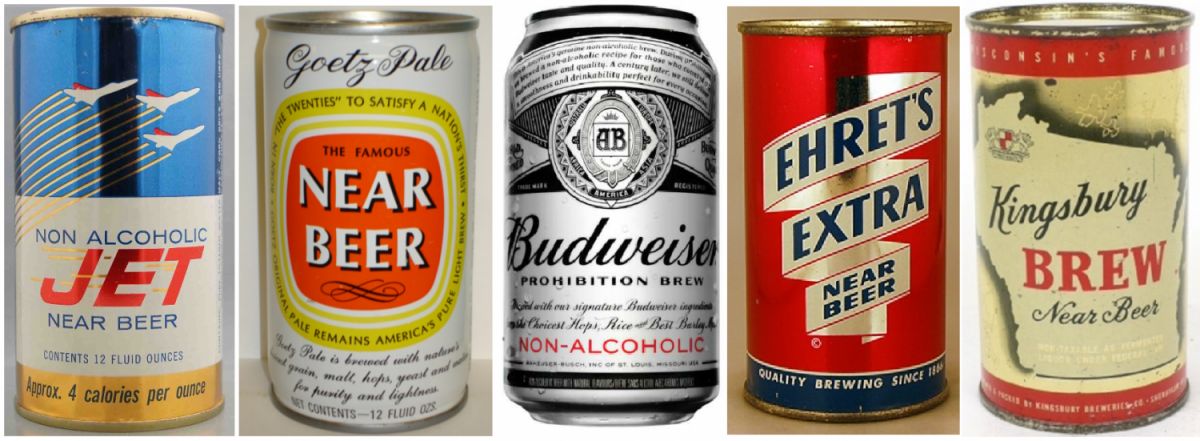
There were further tightening measures in 1921 and 1929, but Prohibition in the USA had a long history, as alcohol was banned in the state of Maine as early as 1851. Initially, many US states only combated the excessive consumption or abuse of alcohol. The two temperance organisations "Women's Christian Temperance Union" (founded in 1874) and "Anti-Saloon League" (founded in 1895) in particular initially campaigned for a limited and then increasingly for a rigorous ban on alcohol. The "Anti-Temperance Societies" formed as a counter-movement, with particular supporters among the Baptists. They continued to regard alcohol as a gift from God.
Anti-Saloon League
The "Anti-Saloon League" in particular was run very professionally by the lawyer Wayne B. Wheeler (1869-1927), who was excellent at raising funds and financiers. The multiple millionaire and owner of the Standard Oil Company John D. Rockefeller (1839-1937) donated 5,000 dollars, impressed by one of Wheeler's speeches. Through skilful lobbying, the ASL ensured that practically no politician could afford not to commit to the League's goals (whether they were convinced is another question).
The success was that before Prohibition came into force on 16 January 1920, alcohol had already been banned by law in 33 of the then 48 US states, albeit to varying degrees. However, the ban was only actually ratified by many states during the First World War, as this was dependent on referendums (so-called "local options"). Taking into account the complicated legal situation in the individual states, more than half of Americans were against alcohol prohibition when the war broke out in 1914.

The First World War supported the efforts of alcohol opponents when the USA entered the war on the side of the Entente against Germany and Austria-Hungary. Most of the breweries in the USA were run by German or Austrian expatriates (e.g. Anheuser-Busch). Winegrowing was mainly the domain of Italians, but in the saloons of workers of Irish and Polish descent, whisky was the main drink. These were mostly Catholic, while the Anglo-Saxon power elite in the USA was traditionally Protestant. The anti-alcohol campaign was mainly the work of Protestant fundamentalists. They labelled German brewery owners as "traitors" or the cause of the alcoholic evil and unleashed a nationalist campaign.
The industrialist Henry Ford I (1863-1947) also supported the endeavours, presumably less for moral reasons than because he did not want to tolerate a reduction in his workers' performance due to alcohol impairment. Any Ford worker who smelled of beer was summarily dismissed without mercy. The strict ban on alcohol was regularly and rigorously monitored by the company's own security staff, including unexpected visits to the workers' homes.
18th Amendment to the Constitution
Finally, a ban was introduced on the sale, production, import and transport of alcoholic beverages. To this end, the Constitution was even amended by the 18th Amendment. It was ratified on 16 January 1919 and came into force on 16 January 1920 (and then repealed in 1933 by the 21st Amendment). Incidentally, the introduction of prohibition against alcohol ran parallel to the introduction of women's suffrage.
Only the sale was considered a criminal offence, not the mere consumption. The demand for alcohol did not end as a result of the ban, on the contrary. The illegal business of production and distribution by criminal, highly organised elements developed in an excessive manner. This led to a frightening increase in crime. So it backfired, because instead of eradicating abuse, the "noble experiment" labelled by its proponents led to an uncontrolled escalation of the black market.
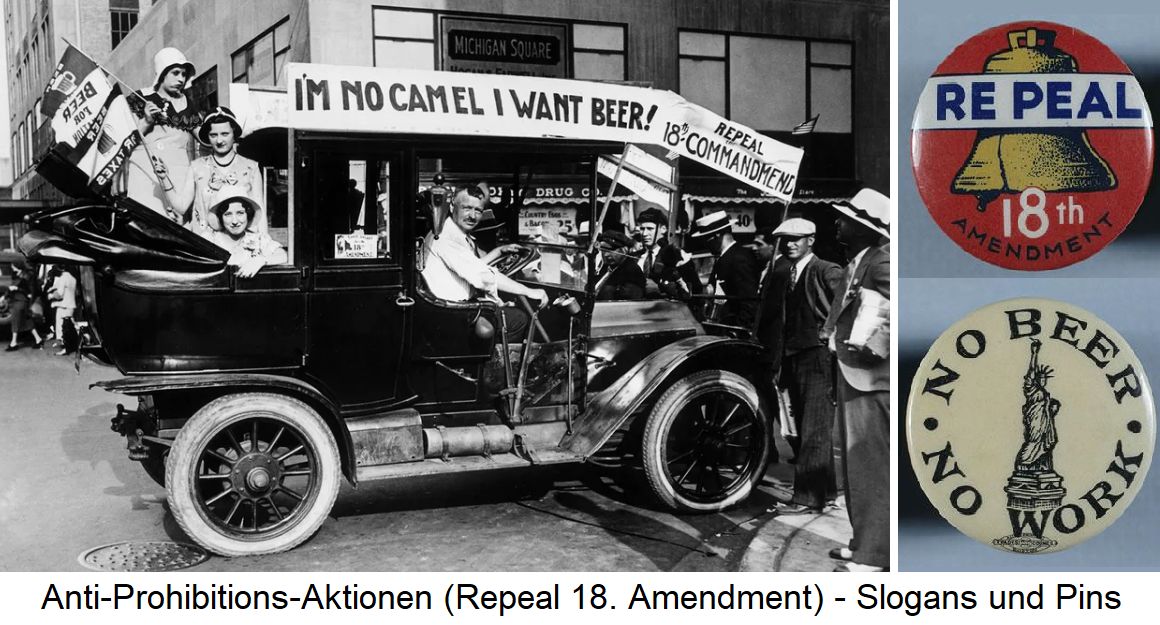
Negative effects
Prohibition did not prevent anyone from drinking. It merely replaced good beer and good wine with bad liquor. There were numerous cases of poisoning by methanol (wood alcohol) and fusel alcohol, because schnapps was often produced under adventurous conditions in the dark of night; this is why the product was aptly called "moonlight whisky" (the picture on the left shows such a "moonshine still"). Religious ceremonies were legally regulated exceptions. This was exploited to the full, as the demand for mass wine suddenly increased enormously and priests became wine sellers. In addition, anyone could found a church in the land of the many free churches.
Wine was also allowed to be used as a spice for food or other applications. Another loophole was that wine could be prescribed as a medicine (a prescription is shown below right). Many doctors were willing to prescribe "medicinal champagne" and medicinal wine could be purchased at any drugstore. Certain alcoholic beverages such as Underberg, a popular bitters in the USA, were excluded from the ban.
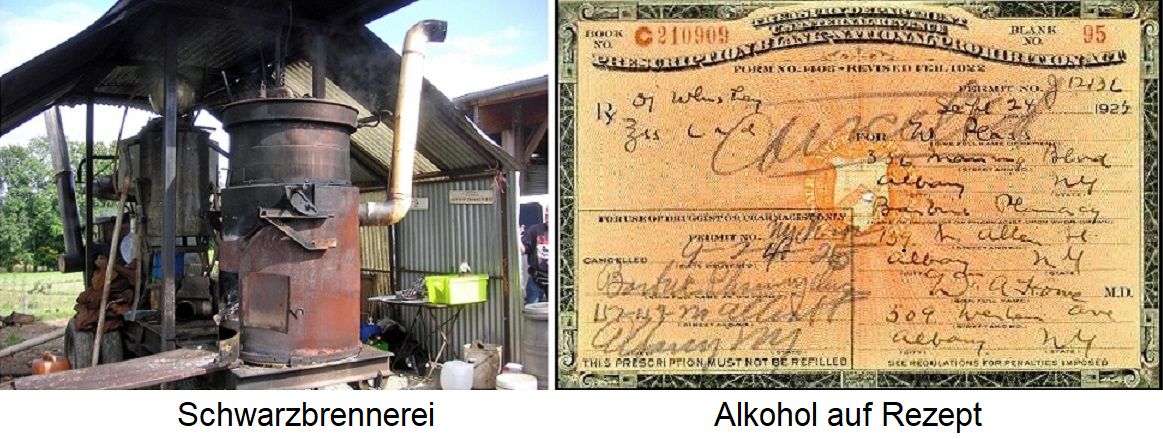
Wine production at home
There were also original ideas to get round the ban without breaking the law. One company produced sultana cake and "warned" in the instructions: "Do not put the sultana cake in the filled bathtub, otherwise it will inevitably start to ferment and turn into wine". Hundreds of thousands of Americans produced their "house wine" in exactly the same way through this clever marketing during the Prohibition era. Grape bricks" made from concentrated grape juice were also marketed, with the warning on the packaging: "Do not add yeast, otherwise the contents will ferment". Another option was to buy grapes, as the law allowed "non-intoxicating fruit and fruit juices to be produced". Many Americans became hobby cellar masters. The new Alicante Henri Bouschet variety was particularly popular and was planted on a large scale.
Increase in crime
From the very first year of Prohibition, a myriad of new, illegal bars emerged that were not recognisable as such from the outside. Interestingly, a large proportion of the patrons were women, who had been forbidden from visiting bars in the legal times - i.e. before Prohibition. The supply of these pubs was mainly controlled by gangster gangs. Probably the most famous gangster boss was the notorious Al Capone (1899-1947).
It was not until Prohibition that the Sicilian mafia became the dominant force in the US underworld. Bribery and intimidation of politicians, police officers and court witnesses were everyday occurrences. Gangs fought gun battles in broad daylight for markets. Above all, it was the escalating violence that turned more and more citizens against the nonsensical law. Those in favour drew the (false) conclusion that even tougher bans would have to be introduced, as was the case for private alcohol consumption (which was still permitted).
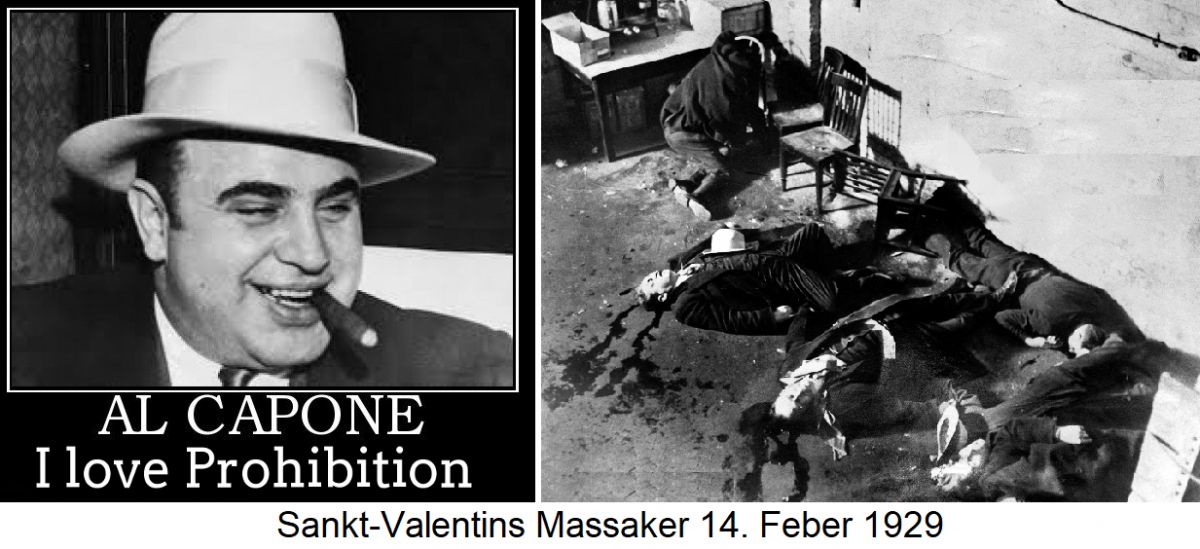
Decline of viticulture
In the USA, there was a total decline in viticulture and wine culture and most winegrowers and wineries went under. Many former wineries now became pure grape producers. The Paul Garett company switched to the production of grape juice from the historic Scuppernong variety. This company was the only producer that was able to produce wine again immediately after the end of the ban in 1933. Wine consumption doubled, but this did not benefit the American wineries. The knowledge of winemaking had been lost. After Prohibition, this also characterised American wine taste for several decades and led to a loss of quality. Mainly sweet wines were produced, which required much less effort to produce.
Repeal of Prohibition
Prohibition also plunged the USA into a social crisis and even led to constitutional discussions. This was because the ban on alcohol contradicted the principles of every individual's right to "personal liberty" enshrined in the Declaration of Independence. The economic crisis of 1929 then brought about a rethink, as the supporters had always claimed that Prohibition was economically sensible. For the 1932 elections, the Democratic Party made repeal one of the most important points in its election programme. The newly elected 32nd US President Franklin Delano Roosevelt (1882-1945) said the legendary sentence: "I think now is the time for a beer".
In 1933, Congress repealed the 18th Amendment of 1919 with the 21st Amendment to the Constitution and introduced the three-tier system. This stipulates that producers, wholesalers and retailers must be strictly separated in the alcohol distribution chain. Corresponding regulations were left to the individual states. Even today, however, there are still strong forces in favour of prohibition in the USA. In 1998, a ban on alcohol was reintroduced in Chicago by referendum. The state of Utah has the strictest rules regarding the consumption of alcohol. In many US states, wine is still treated as a drug.
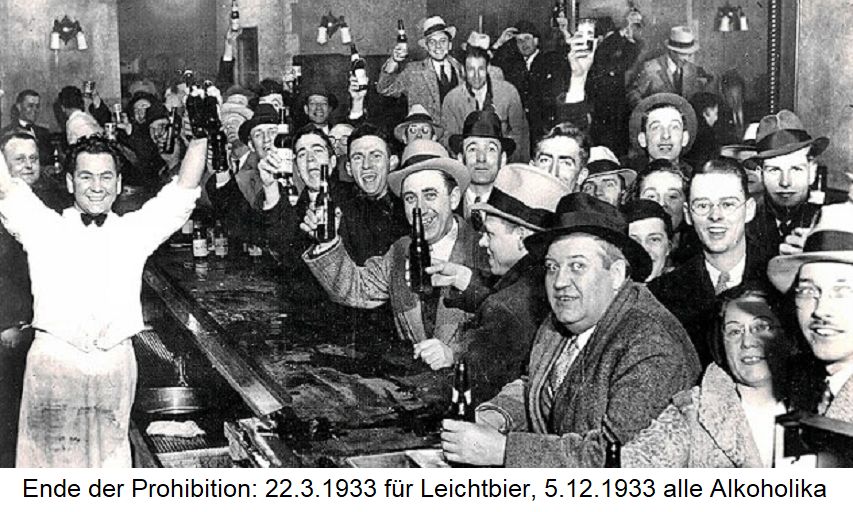
General rules
The consumption of alcoholic beverages is prohibited outside of restaurants. For this reason, there is a special custom of wrapping a bottle of alcohol in a paper bag and drinking from it in this form. Open bottles may not be taken into the car and alcohol in any form may only be transported in the boot. The following text must be included on every bottle of wine sold in the USA as a government warning: Women should not consume alcoholic beverages during pregnancy due to the risk of possible harm to the unborn child. Drinking alcoholic beverages impairs your ability to drive or operate machinery and can lead to health problems.
Further information
The longest-lasting and most rigorous ban on alcohol is the one in Islam, which is applied with varying degrees of strictness in the countries concerned. An interesting website with further information and pictures about prohibition in the USA can be found under the link Prohibition - An Interactive History. See also Alcoholism, as well as lists of relevant keywords under alcoholic beverages and alcohol consumption.
Barrel destruction: Underwodd & Underwood/Corbis
Car and slogan I'm no camel, I want beer: FineArtAmerica.com
Al Capone and St Valentine's Massacre: Hulton-Deutsch Collection/Corbis
End of Prohibition: Prohibition - An Interactive History
Voices of our members

The glossary is a monumental achievement and one of the most important contributions to wine knowledge. Of all the encyclopaedias I use on the subject of wine, it is by far the most important. That was the case ten years ago and it hasn't changed since.
Andreas Essl
Autor, Modena